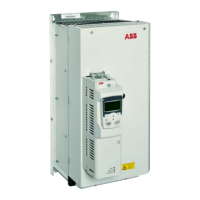Operation
30
Fault Logger
In the Fault Logger option, you can:
• view the drive fault history
• see the details of the most recent faults
• read the help text for the fault and make corrective actions
• start, stop, change the direction and switch between local and remote control.
How to view faults
Step Action Display
1. Go to the Main menu by pressing if you are in the Output mode, otherwise
by pressing repeatedly until you get to the Main menu.
2. Go to the Fault Logger option by selecting FAULT LOGGER on the menu with
keys and , and pressing .
• If there are no faults in the fault history, corresponding text will be shown.
• If there is a fault history, the display shows the fault log starting with the most
recent fault. The number on the row is the fault code according to which the
causes and corrective actions are listed in appropriate firmware manual.
3. • To see the details of a fault, select it with keys and , and press
.
• Scroll the text with keys and .
• To return to the previous display, press .
4. • If you want help in diagnosing the fault, press .
5. • Press . The panel allows you to edit necessary parameters to correct the
fault.
6. • Specify a new value for the parameter with keys and .
• To accept the new value, press .
• To cancel the new value and keep the original, press .
MENU
EXIT
PARAMETERS
ASSISTANTS
CHANGED PAR
EXIT ENTER
00:00
MAIN MENU 1
LOC
ENTER
No fault history
found
MESSAGE
LOC
36: LOCAL CTRL LOSS
29.04.08 10:45:58
FAULT LOGGER
EXIT
DETAIL00:00
LOC
1
DETAIL
EXIT
TIME
10:45:58
FAULT CODE
36
FAULT CODE EXTENSION
LOCAL CTRL LOSS
EXIT
DIAG00:00
LOC
DIAG
Check parameter ‘30.0
3 Local ctrl loss’ se
tting. Check PC tool
or panel connection.
EXIT OK
LOC
OK
3003 Local ctrl loss
PAR EDIT
Fault
EXIT SAVE00:00
[1]
LOC
SAVE
EXIT
3003 Local ctrl loss
PAR EDIT
Spd ref Safe
EXIT SAVE00:00
[2]
LOC

